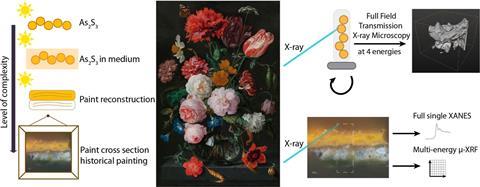An international study has revealed a previously unknown degradation pathway for orpiment (As2S3). The medium appears to play a greater role than previously thought, reports the Journal of the American Chemical Society.

If you want to know how to prevent rust (iron oxidation), you need to understand how rust is formed. The same goes for pigment degradation in old paintings. Researchers from the Rijksmuseum Amsterdam, the Universities of Amsterdam (UvA), Antwerp and Utrecht, and the Stanford Synchrotron Radiation Lightsource studied the yellow pigment orpiment (As2S3) in the seventeenth-century painting Still Life with Flowers in a Glass Vase by Jan Davidszoon de Heem. They used a range of analytical techniques (XANES, SR-based TXM and SR-based µ-XRF) on different pigment models to determine how orpiment reacts further to As(V). They discovered another pathway in addition to the already known degradation pathway..

The models gradually became more complex. The researchers started with pure orpiment, without any medium, at different humidity levels and exposed it to UV light or not to see what effect it had on the ageing process. Then they used different sources of arsenic in tempera as a medium, then linseed oil on a lead-white background (as a reconstruction of the painting), and finally even a piece of the painting itself, to see how they reacted.
The measurements showed that the medium is the main culprit when it comes to degradation. The orpiment partially dissolves, releasing As(III)-OH particles. These react further within a few weeks to form As(V) particles, which spread through the medium and end up in all the layers of the painting. Light played no part in this process.

The researchers also found that the ‘normal’ light degradation product of orpiment, arsenolite (As2O3), also degrades via As(III) to As(V) particles. When these come into contact with other metal ions, they can form new substances that can lead to cracking and spalling. The team expresses concern that the short period of time in which degradation occurs compromises the safety of paintings containing arsenic sulphide, and that conservators should be aware of this.
Broers, F.T.H. et al. (2023) J. Am. Chem. Soc., doi.org/10.1021/jacs.2c12271













Nog geen opmerkingen